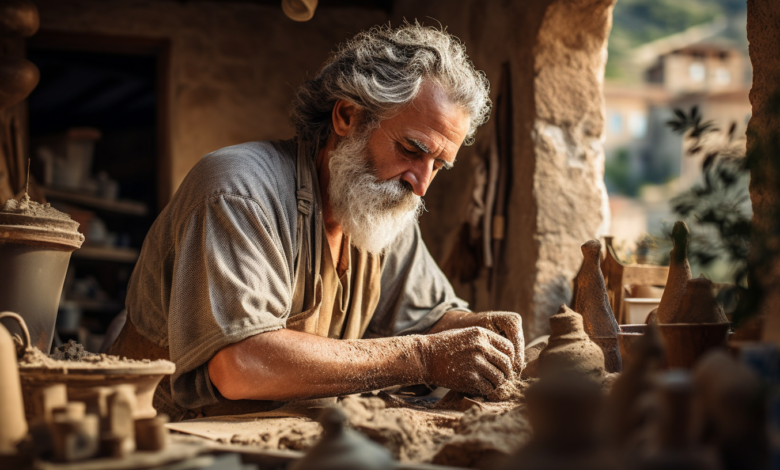Craftsmanship and Tradition: Preserving the Art of Traditional Craftsmanship

In a world driven by rapid technological advancements and mass production, the enduring allure of craftsmanship and tradition remains a testament to the value of human skill, cultural heritage, and sustainability. Traditional craftsmanship, an artisanal practice often passed down through generations, plays a crucial role in preserving cultural heritage, supporting local economies, and promoting sustainable production methods. This article explores the importance, techniques, and future of craftsmanship and tradition, delving into how these practices offer value beyond just physical products.
The Essence of Craftsmanship
At its core, craftsmanship is the art of creating items with care, skill, and dedication. Each piece produced by an artisan is unique, imbued with a story and a history that can’t be replicated by mass-produced goods. Craftsmanship methods focus on quality and durability, incorporating knowledge and skills honed over years or even centuries. From traditional weaving techniques and woodworking to dyeing and pottery, craftsmanship offers an intimate connection to the past, blending tradition with contemporary needs.
Traditional Craftsmanship: The Value and Role
Traditional craftsmanship is a bridge between generations, helping to preserve cultural heritage while ensuring that traditional skills are passed on to future generations. This craftsmanship encompasses a wide variety of techniques that vary across cultures, each telling a story of the community and the values it upholds. For instance, traditional textile weaving and woodworking techniques often reflect the region’s resources, climate, and history. These items are typically made to last, incorporating natural materials and emphasizing quality over quantity.
The role of traditional craftsmanship is not just about creating goods but also about sustaining a way of life. Craftspeople play a vital role in the survival of traditional crafts, providing employment opportunities for local communities and contributing to the intangible cultural heritage of a region. Through the practice of traditional craftsmanship, artisans preserve the knowledge and expertise that have been passed down from one generation to the next, ensuring that these skills remain alive.
Artisans: The Heart of Craft Traditions
Artisans are at the heart of traditional craftsmanship. These skilled individuals or groups work with materials like wood, textiles, metal, and clay to create items that reflect their cultural heritage. Traditional craftsmen and craftswomen often use techniques passed on through generations, blending skill with a personal touch that makes each item unique. The human touch in these crafts lends an irreplaceable value that cannot be achieved through machine production. Artisans also play a role in supporting local economies, as their products promote and celebrate regional cultural heritage while also providing income and livelihood.
Handcrafted goods are often created using traditional skills, which emphasizes the importance of learning, mastering, and refining a craft over time. This dedication contrasts sharply with today’s fast-paced, throwaway culture. Artisans who embrace traditional craftsmanship focus on producing quality items, taking pride in every piece they make.
Cultural Heritage and Traditional Skills: Preserving the Past, Shaping the Future
Traditional craftsmanship offers more than tangible products; it safeguards cultural heritage by preserving the skills, knowledge, and values of previous generations. Cultural heritage, both tangible and intangible, is vital for maintaining a sense of identity and continuity within a community. Intangible cultural heritage includes knowledge, skills, beliefs, and traditions that shape a community’s identity, such as the techniques involved in creating a traditional textile, woodworking designs, or dyeing methods.
Preserving traditional crafts is crucial to ensuring that these cultural elements are not lost to time. By passing down traditional skills, craftspeople help maintain a continuity of cultural practices, blending tradition with modern needs. This continuity is essential for creating a future that values quality, sustainability, and respect for cultural diversity.
The Advantages of Traditional Craftsmanship
In a world where fast fashion and mass production dominate, traditional craftsmanship offers several advantages:
- Quality and Durability: Traditional craftsmanship methods prioritize the creation of high-quality items that are made to last. Each piece is meticulously crafted with a focus on detail, making it less prone to wear and tear compared to mass-produced goods.
- Sustainability: Craftsmanship methods often use eco-friendly materials and practices, reducing environmental impact. Traditional craftsmen use natural materials like wood, cotton, and plant-based dyes, which are less harmful to the environment than synthetic alternatives. This approach helps create a more sustainable world, reducing the need for disposable items and promoting goods that are made to last.
- Cultural Preservation: Traditional craftsmanship techniques are integral to preserving cultural heritage. They embody the values, beliefs, and skills of a community, providing a tangible link to the past. Supporting traditional craftsmanship helps keep these traditions alive, promoting cultural diversity and a sense of pride in local heritage.
- Supporting Local Economies: Artisans and traditional craftsmen provide employment opportunities for local communities, supporting regional economies. By purchasing artisanal goods, consumers can contribute directly to the livelihood of craftspeople, helping to sustain traditional craft industries.
- Unique and Authentic Products: Unlike mass-produced goods, handcrafted items are unique, reflecting the personality and skill of the artisan. Each piece tells a story and holds a level of authenticity that can’t be replicated by machine production.
Blending Tradition with Modernity: A New Age for Traditional Crafts
Today, there is growing interest in traditional craftsmanship as consumers seek items with a personal touch, quality, and a lower environmental impact. Many artisans are blending tradition with contemporary design, creating products that resonate with modern tastes while staying true to traditional techniques. This evolution of traditional crafts offers opportunities for artisans to reach new markets and adapt their skills to today’s world.
Designers are increasingly collaborating with artisans, embracing traditional skills and incorporating them into contemporary designs. This collaboration helps keep traditional craftsmanship relevant, ensuring that traditional crafts are not only preserved but also evolve to meet modern demands. By merging old and new, artisans and designers play a crucial role in creating a future that respects the past while embracing innovation.
Ensuring that Traditional Crafts Survive: Challenges and Opportunities
Despite their cultural and economic significance, traditional crafts face several challenges. The lure of mass production and lower-cost goods often makes it difficult for artisanal products to compete in the mainstream market. Additionally, younger generations may be reluctant to pursue traditional crafts due to a perceived lack of financial stability. However, efforts to preserve traditional craftsmanship through education, government support, and consumer awareness are creating new opportunities.
Governments, non-profit organizations, and cultural institutions are recognizing the importance of preserving traditional craftsmanship as part of a region’s intangible heritage. Programs that promote apprenticeship and training help ensure that these skills are passed down to the next generation, allowing artisans to continue their craft. Additionally, increased awareness of the environmental impact of mass production has sparked interest in supporting sustainable, handcrafted products, further promoting traditional craftsmanship.
Supporting Traditional Craftsmanship: How Consumers Can Help
Consumers play a vital role in preserving traditional craftsmanship by choosing to support local artisans and buy handcrafted goods. By purchasing products made with traditional craftsmanship methods, consumers contribute to the livelihood of artisans and promote sustainable production practices. This support not only keeps craft traditions alive but also encourages a shift towards a more sustainable economy that values quality over quantity.
Additionally, consumers can help raise awareness about the importance of traditional craftsmanship by sharing the stories of artisans and promoting the value of handcrafted goods. Social media and online platforms provide an excellent opportunity for artisans to reach a wider audience, showcasing their skills and the unique qualities of their products.
The Future of Craftsmanship and Tradition: A Path Towards Sustainability
As the world moves towards a more sustainable future, traditional craftsmanship has an essential role to play. Craftsmanship methods, which focus on using natural materials and creating durable items, are inherently sustainable. By choosing quality and durability over disposable, mass-produced items, we can reduce our environmental impact and promote a culture of sustainability.
The value of traditional craftsmanship extends beyond the items created; it’s a way of life that respects the earth and the resources it provides. Craftsmanship is a testament to human skill and ingenuity, offering an alternative to the waste and excess of mass production. By embracing traditional craftsmanship, we can create a world that values quality, respects cultural heritage, and promotes sustainability.
Craftsmanship and Tradition: A Lasting Legacy
In conclusion, craftsmanship and tradition are not just relics of the past but vibrant practices that hold profound relevance in our modern world. They provide a sustainable alternative to mass production, support local economies, and preserve cultural heritage. Every piece crafted by an artisan embodies knowledge, skill, and a connection to the past, offering a glimpse into the rich cultural heritage of communities around the world.
The value of traditional craftsmanship is not just in the products created but in the skills and knowledge passed down through generations. By supporting traditional craftsmanship, we can ensure that these skills remain alive, offering a future where quality, sustainability, and respect for cultural diversity are valued. Craftsmanship and tradition remind us of the importance of human creativity and resilience, leaving a legacy that can be cherished by generations to come.
Craftsmanship, traditional craftsmanship, and the artisans who keep these skills alive are more than just creators of goods; they are stewards of culture, sustainability, and quality. Their work is a testament to the beauty and value of handcrafted items in a world where authenticity and tradition are increasingly sought after. By preserving traditional craftsmanship, we keep our traditions alive and create a legacy that celebrates human skill, cultural heritage, and a commitment to a sustainable future.



